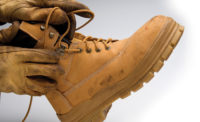Keep ’em clean
The first step to keeping any pair of boots in good shape is to remove dirt, mud and debris as soon as possible; get rid of any caked-on mud, rocks stuck in the outsole, or any other visible dirt. It is best to do this on a regular basis as the boots get dirty. At the end of each day, try to knock off excess dirt or hose boots down to remove as much dirt as possible. It doesn’t need to be a thorough cleaning daily, but the more removed after each wear, the better.
Occasionally, a more thorough cleaning should be done. Using a stiff scrub brush, knock off any mud or debris from the outsole and upper. On a Goodyear welted boot, it is important to remove dirt that may have gotten in between the welt and the upper. It’s important to use the stiff scrub brush along the welt to remove as much dirt as possible. Dirt and grime that work their way beneath the welt can decrease the lifespan of the boot.
In some cases a scrub brush alone will be enough to remove the dirt. If this isn’t enough, warm water can be used along with the scrub brush to help loosen the dirt. If there is really tough dirt embedded into the boot or stains are an issue, a little dish soap can be used in conjunction with the scrub brush to help clean the boot. Beware of using harsh cleaning solvents as they can damage the leather.
After all this, the boots should be clean and free of dirt. It is important to let the boots dry if any water was used in the cleaning process. Avoid quickly drying the boots with a high heat source; this will decrease the lifespan of the leather and cause it to crack. It is better to let them dry naturally. Airflow is key when drying boots and can be greatly aided by taking the laces out and opening the boot up as much as possible, as well as removing the footbed completely. If time is an issue, place them in front of a fan or in the sunlight to help speed the drying process.
Condition leather
Once the boots are clean, it is important to condition the leather to restore the oils to it. Leather is a natural material and over time, the oils in the leather will evaporate, causing it to dry out and crack if not properly conditioned. The harsh conditions found on many worksites only accelerate this. Leather that is properly conditioned will last longer, be more flexible, and will better resist dirt and debris. It’s also important to make sure the boot is dry before applying any kind of leather conditioner.
There are hundreds of options out there when it comes to choosing a leather conditioner and what works for one situation may not work for another. For light-duty applications, a simple leather cream may be enough to restore the leather. For heavy-duty applications, look for something that has more waxes or water-resisting components. The most important factor is that the component restores the oils to the leather. Also note that many leather conditioners can change the color of the leather. In many cases, the color change will not be permanent and the color will lighten up as the leather absorbs the conditioners; however some compounds will permanently change the color. It is best to test the substance on an inconspicuous spot to see how it will look.
Make the most of your boots
If well maintained, a pair of work boots can provide years of service. The frequency of cleanings will depend on how often the boots are worn and under what conditions. Light-use work boots may only need to be cleaned and conditioned twice a year, while boots that see harsh daily conditions may need to be cleaned every two months. A good pair of work boots is an investment and taking proper care of them will ensure they live long and protect well.




